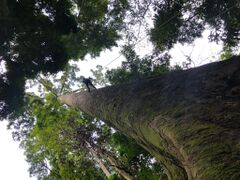Verona: Difference between revisions
mNo edit summary |
mNo edit summary |
||
| Line 136: | Line 136: | ||
Verona is considered a global trendsetter in popular culture, innovation, and politics. It is the origin of the {{wp|film industry}}, the {{wp|Internet}}, and the {{wp|personal computer}}, among others. The Palm Coast Metro area is widely seen as a center of the global technology and entertainment industries, respectively. Verona has a very diverse economy: fifty-eight percent of the state's economy is centered on {{wp|financial services|finance}}, government, {{wp|real estate|real estate services}}, technology, and professional, scientific and technical business services. Although it accounts for only 1.5 percent of the state's economy, Verona's agriculture industry has the highest output of any Cartadanian state, and although it is not a coffee-producing state, it does export a large amount of coffee shipped from other states. | Verona is considered a global trendsetter in popular culture, innovation, and politics. It is the origin of the {{wp|film industry}}, the {{wp|Internet}}, and the {{wp|personal computer}}, among others. The Palm Coast Metro area is widely seen as a center of the global technology and entertainment industries, respectively. Verona has a very diverse economy: fifty-eight percent of the state's economy is centered on {{wp|financial services|finance}}, government, {{wp|real estate|real estate services}}, technology, and professional, scientific and technical business services. Although it accounts for only 1.5 percent of the state's economy, Verona's agriculture industry has the highest output of any Cartadanian state, and although it is not a coffee-producing state, it does export a large amount of coffee shipped from other states. | ||
Verona borders [[Trentino]], [[Santiago]], [[Alexandria]], and the capital city of [[Alahuela]] to the west and north, [[Catania]] to the south, and [[Roma | Verona borders [[Trentino]], [[Santiago]], [[Alexandria]], and the capital city of [[Alahuela]] to the west and north, [[Catania]] to the south, and [[Alta Roma]] and [[Roma Sur]] to the east. It also shares an international maritime border with the [[Caphiria]]n province of [[Turiana]]. | ||
== History == | == History == | ||
Revision as of 12:26, 18 November 2021
Script error: The module returned a nil value. It is supposed to return an export table.
Verona | |
|---|---|
| Commonwealth of Verona Comunidade da Verona | |
| Nickname: The Palmetto State | |
| Motto: Brilho | |
| Anthem: De Amor, Verona | |
 Map of Cartadania with Verona highlighted | |
| Country | |
| Before statehood | Republic of Verona |
| Admitted to the Union | 3 November 1710 (2nd) |
| Capital | Georgetown |
| Largest city | Sierra |
| Largest metro | Palm Coast metropolitan area |
| Government | |
| • Governor | Alícia Rosa |
| • Lieutenant Governor | Micah Santander |
| Legislature | Verona General Assembly |
| • Upper house | Senate |
| • Lower house | House |
| Judiciary | Supreme Court of Verona |
| Senators | 3 |
| Chamber delegation | 104 |
| Area | |
| • Total | 392,927 km2 (151,710 sq mi) |
| • Rank | 1st |
| Dimensions | |
| • Length | 1,189 km (739 mi) |
| • Width | 681 km (423 mi) |
| Elevation | 793 m (2,601.7 ft) |
| Highest elevation | 4,529.6 m (14,861.1 ft) |
| Lowest elevation | 0 m (0 ft) |
| Population | |
| • Total | 76,239,415 |
| • Rank | 1st |
| • Density | 194.0/km2 (502.5/sq mi) |
| • Median household income | €88,620 |
| • Income rank | 3rd |
| Demonym | Veronese |
| Language | |
| • Official language | Cartadanian |
| • Spoken language |
|
| Time zone | UTC-1:00 (Central Standard Time) |
| CCor abbreviation | VA |
| ISO 3166 code | CA-VA |
| Trad. abbreviation | Ver. |
| Website | www |
| Verona state symbols | |
|---|---|
 | |
 | |
| Living insignia | |
| Amphibian | Hyla cinerea |
| Bird | Mimus polyglottos |
| Butterfly | Morpho rhetenor |
| Flower | Hibiscus |
| Mammal |
|
| Reptile | Phelsumis grandis |
| Tree | Venezano palm |
| Inanimate insignia | |
| Dinosaur | Sienaraptor |
| Food | Pineapple |
| Fossil | Megalodon |
| Gemstone | Aquamarine |
| Mineral | Beryl |
| Motto | Brilho |
| Nickname | The Palmetto State |
| Shell | Queen conch |
| Song | De Amor, Verona |
| State route marker | |
 | |
| List of Cartadanian state symbols | |
Verona, officially the Commonwealth of Verona (Cartadanian: Comunidade da Verona), is a state located on the eastern coast of central Cartadania. With 76.2 million residents across a total area of about 392,847 square kilometers (151,679 mi), Verona is the most populous and most extensive state in Cartadania. The state capital is the city of Georgetown in central Verona. The Palm Coast metro area is the most populous urban region in the country, with 31.7 million residents, more populous than every state except Santiago and Verona itself. Sierra is Verona's, as well as Cartadania's, most populous city. Verona also has the nation's most populous county, Sierra County, which is also one of its largest counties by area.
Verona's diverse geography ranges from the Urlazio Coast in the east to the Serra Afiada mountain range in the center to the everglades and its meranti forests in the west; and from the meranti forests to the Lençois Desert in the southwest. The Central and Chesapeake Valleys, major agricultural areas, dominate the state's center. Though Verona is well-known for its warm tropical climate, the large size of the state means it can vary from rainforest in the west, to arid desert in the south, and nearly alpine in the mountains.
Verona's €6.267 trillion economy is larger than that of any other state, and more than €2.5 trillion ahead of the next largest economy, Santiago. If it were a country, Verona would be the 15th largest economy in the world, and the 25th most populous. The Palm Coast Metro area is the nation's largest urban economy, accounting for roughly 42 percent of the state's GSP.
Verona is considered a global trendsetter in popular culture, innovation, and politics. It is the origin of the film industry, the Internet, and the personal computer, among others. The Palm Coast Metro area is widely seen as a center of the global technology and entertainment industries, respectively. Verona has a very diverse economy: fifty-eight percent of the state's economy is centered on finance, government, real estate services, technology, and professional, scientific and technical business services. Although it accounts for only 1.5 percent of the state's economy, Verona's agriculture industry has the highest output of any Cartadanian state, and although it is not a coffee-producing state, it does export a large amount of coffee shipped from other states.
Verona borders Trentino, Santiago, Alexandria, and the capital city of Alahuela to the west and north, Catania to the south, and Alta Roma and Roma Sur to the east. It also shares an international maritime border with the Caphirian province of Turiana.
History
The first inhabitants
Settled by successive waves of arrivals during the last 10,000 years, Verona was one of the most culturally and linguistically diverse areas in Ixnay. Various estimates of the native population range from 100,000 to 300,000. The Indigenous peoples of Verona included more than 30 distinct groups of Native Cartadanians, ranging from large, settled populations living on the coast to groups in the interior. Verona groups also were diverse in their political organization with bands, tribes, villages, and on the resource-rich coasts, large chiefdoms, such as the Veronesi, Guanches and Vartuli. Trade, intermarriage and military alliances fostered many social and economic relationships among the diverse groups. Whether a Native tribe was friendly or warlike was critical to the fates of Latin explorers and settlers in that land. Friendly tribes taught newcomers how to grow indigenous crops, prepare foods, and hunt wild game. Warlike tribes made life difficult and dangerous for Latin settlers through their attacks and resistance to the newcomers.
Colonial and Latin periods
Because of Verona's long history as a banlieuregio of Caphiria, the impact of Caphirian culture was strong, especially during the first two centuries following Verona's creation. Due to it's equatorial climate and vast size, Verona spent much of its time as a diversified land. It served as an agricultural hub for Caphiria, and through Caphiria's trade networks, much of the world. It also served as a tourist destination for many Caphirians seeking a more distinct vacation. The long white sand beaches attracted many from around the world as well, especially from Levantia.
Verona originally encompassed what is today, Santiago and Trentino, as well as it's present day area. It was bound by a loose government structure that contained settlements such as Amelia, Lynnhaven, and Viridans, which served as important locations for the Imperium. Much of Verona's colonial period was quite dormant outside of development of the region in terms of trade, which would eventually diminish in favor of trade from Luria and Auvia.
Verona further formed the state of Santiago from its Columbia, Sancti, and Tridentum regions toward the end of it's colonial era. Though never officially a region, Sancti served as Verona's playground in terms of developing new "technology" and advancement as a Banlieuregio.
Republic of Verona and Caphirian invasion

Due to the imperium's constant neglect of Verona in favor of other, more centrally located provinces, Verona's autonomous government passed a law known as the Vermillion Act, which effectively separated the province from the imperium, creating a wall between Verona (and its territory, Sancti) and the Alexandria province north of Verona. Initially, the imperium took little notice to this separation, choosing to overlook it as an international publicity stunt. Things began to change, however, when Verona began to issue its own money, the Veronese Lira, backed at a value higher than that of the Taler. This value was further increased by low circulation, Verona's now incredibly diverse economy, its desirable location, and an exploding population. With similar sentiments of the Burgoignesc for freedom from their national governments, Verona began to develop support on an international stage. It officially codified its initial set of laws as a nationstate in 1426, under the name REPVBLICA VERONEZE, and rewrote all of its information, culture, and signage in its local dialect, of which would eventually standardize into Early Cartadanian half a century later.
The imperium, noticing the growing notoriety of the young republic, began to develop a particular feeling of betrayal, going so far as to consider acts of the people of Verona treasonous. As a result, the imperium proceeded to declare a form of marshall law and nearly razed the young republic's infrastructure in an effort to bring it into submission. The result was, of course, Verona's forced re-entry into the imperium. Despite this, however, Verona's disdain for Venceia's rule began to spread and grow not only in Verona, but in Alexandria and Sancti as well. It would go so far as a double-sided operation by Verona's leadership to assist in granting Sancti provincial status so that it would have more power. In the years that followed this invasion, the governments of Alexandria, Sancti, and Verona began very secretive talks of another separation from the imperium.
Union with Alexandria and Santiago
In the the late 1660s, Verona redivided itself into 12 municipios which served as the precursors for Verona's 53 modern counties and are identical to the boundaries of Verona's modern metro areas. In 1671, Verona again seceded from Caphiria, this time taking Alexandria and Sancti, now renamed Santiago from the Cartadanian language equivalent, along with it. The three independent provinces again cited Venceia's neglect of the area for the reason of separation. This time, although Caphiria attempted to bring the three provinces back into the imperium, was torn between the aftermath of the Great Schism and the changing nature of life in Venceia. Inevitably, Venceia withdrew its military from Verona and Alexandria, which generated a de facto new nation, one without name or identity.

Naturally, Alexandria and Santiago looked to Verona for guidance on this as Verona had already been a short-lived nationstate in the past. Over the course of the next 9 years, the three provinces united into the first Republic of Cartadania, written REPVBLICA CARTADANIANA, itself named indirectly for the Carto-Latinic people of the Lusitan peninsula in northern Sarpedon. The union was quite weak and generally served as the basis for what would become the second Cartadanian Republic. The three entities developed an economic model and other aspects that would lead to the development of a stronger nation.
During this period, Verona saw a large urbanization, especially around what is today the Palm Coast. Sierra, previously a small town, began to explode in population and the resulting population growth drastically expanded Verona's economy. It was also around this time that Verona's government moved from Sierra to a more central location in what would become the city of Georgetown. There were a lot of births around this time as well, coinciding with the birth of the new nation. It was also during this time, however, that the country saw what would become the bloodiest conflict on domestic soil.
Early Cartadanian statehood period

In 1697, approximately 17 years after Verona had united with Santiago and Alexandria, things took a turn for the worst. The elite that still oversaw Verona and the other two states through monetary means began to overextend Verona's money and resources for their benefit, which ultimately saw the middle and lower class being neglected by the people they trusted to protect them. As a result, early Cartadania was thrust into a civil war between the wealthy elite and the growing middle and lower class who was becoming poorer by the day. The resulting massacre of many of Cartadania's elite and the forced deportation of three-quarters of Cartadania's upper class would lead to the creation of modern-day Galicia, Ceylonia, and Porlos. The then-governor of Verona was executed during this period as well, which saw Verona enter a period of disarray. The aftermath of this situation and the subsequent eleven year period that followed saw the recreation of Cartadania from a largely capitalist society into a heavily socially democratic one with capitalist aspects.
On 29 October 1709, the governments of the three states called for the creation of a new capital, originally to sit between the three states with land ceded from all three. It was during this period, however, that the west Urlazian provinces, then still part of Caphiria, began to experience the same neglect that Verona faced starting nearly 300 years before. Consequently, to keep the capital centralized and accessible by sea, the three states decided to place the capital between Alexandria and Verona along the Urlazian coast. During this period, Verona also renamed it's municipios to counties (Cartadanian: comarcas), which would continue to divide into the counties of today. Verona's population continued to skyrocket and it was at this time that the State of Verona (Cartadanian: Estado da Verona) was renamed to the Commonwealth of Verona (Cartadanian: Comunidade da Verona). Verona's population, although high, was still quite low in comparison to Alexandria, which served as the capital of the Lusos region during the earlier Caphirian historical periods. This, of course, would change in the coming decades.
21st century
Geography
Climate
Although most of the state has a mixed tropical climate, due to the state's large size, the climate ranges from subarctic/alpine to tropical. The cool Ecinian Current offshore often creates summer fog near the coast. Farther inland in mountainous areas, there fluctuation in temperature throughout the year. The maritime moderation results in the shoreline "summer" temperatures of Los Sueños and Sierra being the coolest of all major metropolitan areas of Cartadania and uniquely cool compared to areas on the same latitude in the interior. Even the Volusia County shoreline bordering Pelaxia is cooler in summer than most areas. Just a few miles inland, summer temperature extremes are significantly higher, with downtown Alpharetta being several degrees warmer than at the coast. The same microclimate phenomenon is seen in the climate of the Bay Area, where areas sheltered from the sea sees significantly hotter summers than nearby areas close to the ocean.
Ecology
Verona is one of the richest and most diverse parts of the world, and includes some of the most endangered ecological communities. Verona is part of the Neotropic ecozone and spans a number of terrestrial ecoregions.
Verona's large number of endemic species includes relict species, which have died out elsewhere, such as the Catalina ironwood (Lyonothamnus floribundus). Many other endemics originated through differentiation or adaptive radiation, whereby multiple species develop from a common ancestor to take advantage of diverse ecological conditions. Many Verona endemics have become endangered, as urbanization, logging, overgrazing, and the introduction of exotic species have encroached on their habitat.
Flora and fauna
Verona is characterized by savannas, bayous, creeks, woodlands, deserts, and beaches. The diversity of the state's geography and climate makes it quite unique, even for Cartadania. The generally tropical to mediterranean climate has made Verona a very comfortable home for many species of plants and animals. In fact, Verona is the most megadiverse state in the country with 206 amphibian species, 181 reptile species, 715 bird species, and 190 mammal species, as well as nearly 900 species of tree and other vegetation. This includes the yellow Meranti, the tallest tropical tree on the planet found within the state's everglades.
-
Venezano palm, the state tree
-
Eastern puma, state land mammal
Rivers
Regions
Demographics
Population
Racial and ancestral makeup
Languages
Government and politics
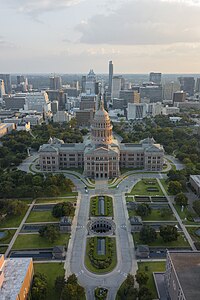
The state's capital is Georgetown. Verona is organized into three branches of government – the executive branch consisting of the Governor and the other independently elected constitutional officers; the legislative branch consisting of the House of Representatives and Senate; and the judicial branch consisting of the Supreme Court of Verona and lower courts. All candidates in the primary elections are listed on the ballot with their preferred party affiliation, but they are not the official nominee of that party. At the primary election, the two candidates with the top votes will advance to the general election regardless of party affiliation. If at a special primary election, one candidate receives more than 50% of all the votes cast, they are elected to fill the vacancy and no special general election will be held.
Legislative Branch
The Verona General Assembly is a bicameral body consisting of a lower house, the Verona House of Representatives, with 120 members, and an upper house, the Senate of Verona, with 80 members. Combined together, the Verona General Assembly consists of 200 elected representatives from an equal number of constituent districts across the commonwealth. The General Assembly holds sessions in the Verona State Capitol in Georgetown.
The House of Representatives is presided over by the Speaker of the House, while the Senate is presided over by the Lieutenant Governor of Verona. The House and Senate each elect a clerk and sergeant-at-arms. The Senate of Verona's clerk is known as the Secretary of the Senate. The General Assembly also selects the Commonwealth's Auditor of Public Accounts. The statutory law enacted is codified in the Code of Verona.
Executive Branch
The Verona executive branch consists of the Governor of Verona and seven other elected constitutional officers: Lieutenant Governor, Attorney General, Secretary of State, State Controller, State Treasurer, Insurance Commissioner, and Superintendent of Education. The governor serves as chief executive officer of the Commonwealth and as commander-in-chief of its militia. The Lieutenant Governor serves as president of the Senate of Verona and is first in the line of succession to the governor. The Attorney General is chief legal advisor to the governor and the General Assembly, chief lawyer of the Commonwealth and the head of the Department of Justice. The attorney general is second in the line of succession to the governor. Whenever there is a vacancy in all three executive offices of governor, lieutenant governor, and attorney general, then the Speaker of the House of the Verona House of Representatives becomes governor.
Judicial Branch
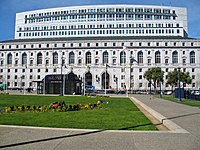
Verona's legal system is explicitly based upon common law (as is the case with all other states except Haia and São Andreas) but carries a few features from civil law, such as community property. Capital punishment is a legal form of punishment and the state has the largest "Death Row" population in the country (though there are states that are far more active in carrying out executions, such as Lombardia). Despite this Verona is nominally, and typically in practice, a rehabilitative state, meaning most criminals go through rehabilitation and re-entry into society.
Verona's judiciary system is the largest in Cartadania (with a total of 3,200 judges, while the federal system has only about 1,680). At the apex is the seven Justices of the Supreme Court of Verona, while the Verona Courts of Appeal serve as the primary appellate courts and the Verona Superior Courts serve as the primary trial courts. Justices of the Supreme Court and Courts of Appeal are appointed by the Governor, but are subject to retention by the electorate every 12 years. The administration of the state's court system is controlled by the Judicial Council, composed of the Chief Justice of the Supreme Court of Verona, 14 judicial officers, four representatives from the Commonwealth Bar of Verona, and one member from each house of the state legislature.
The Supreme Court of Verona meets in the Javier Padrón Commonwealth Justice building, just east of Downtown Georgetown.
Local government
Counties
Verona is currently divided into 53 counties. The county government provides countywide services such as law enforcement, jails, elections and voter registration, vital records, property assessment and records, tax collection, public health, health care, social services, libraries, flood control, fire protection, animal control, agricultural regulations, building inspections, ambulance services, and education departments in charge of maintaining statewide standards. In addition, the county serves as the local government for all unincorporated areas. Each county is governed by an elected board of supervisors.
Residents of a sufficiently large piece of unincorporated county land can incorporate a city. The city government then takes some of the tax revenue that would have gone to the county, and can impose additional taxes on its residents. It can then choose to provide almost all the services usually provided by the county (and more), or provide only a few and pay the county to do the rest. A city in this last arrangement is called a contract city.
Incorporated cities
Like municipalities in most other states, incorporated cities are municipalities that are within counties. Local government is thus divided between the city and the county. A city can be formed from any area with a defined boundary having a population of 1,000 or more. The method for forming cities starts with petitioning the state legislature to grant a charter. As of 2020, there are 624 incorporated cities in Verona.
Although Verona permits cities and counties to enter "interlocal agreements" to share services, the state does not allow consolidated city-county governments, nor does it have metropolitan governments (PCCMCG is a consortium of county governments). The state does not have townships— areas within a county are either incorporated or unincorporated. Incorporated areas are part of a municipality. The county provides limited services to unincorporated areas and to some smaller incorporated areas. Municipalities are classified either "general law" cities or "charter". A municipality may seek charter status once it exceeds 20,000 population with voter approval. General-law cities owe their existence to state law and are consequently governed by it; charter cities are governed by their own city charters. Cities incorporated in the 19th century tend to be charter governed. All ten of the state's most populous cities are charter cities. Most small cities have a council–manager form of government, where the elected city council appoints a city manager to supervise the operations of the city. Some larger cities have a directly-elected mayor who oversees the city government. In many council-manager cities, the city council selects one of its members as a mayor, sometimes rotating through the council membership—but this type of mayoral position is primarily ceremonial.
Verona also permits the creation of "special districts", which provide limited services. The most common is the school district, but can also include hospital districts, community college districts, and utility districts. Municipal, school district, and special district elections are nonpartisan, though the party affiliation of a candidate may be well-known. Partisan elections in charter counties depend on the laws enacted by the county, while general law county and state elections are partisan.
Education
K-12 Education
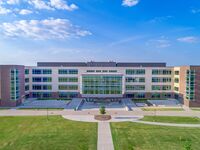
In Verona, each school district is run by a school board. The elected council of the school board helps determine educational policy within the boundaries of the school district, its taxable area, which is "independent" of local government authority. The board also has the ultimate say in the hiring and firing of principals and superintendents, and other district-wide administrative positions. The employment of teachers in individual schools however, is usually left to the principal and administrative staff of the respective schools.
Between 2018 and 2019, Verona spent €17,901 per pupil ranking it well above the national average of €13,389. The pupil/teacher ratio was 14.9, below the national average of 17.3. Verona paid full-time instructors €76,432, well above the national average of €46,593. The Verona Department of Education (VDOE) administers the state's public school systems. Verona has over 200 school districts- all districts except the Varina Municipal School District are independent from municipal government but few cross city/county boundaries. School districts have the power to tax their residents and to assert eminent domain over privately owned property. Due to court-mandated equitable school financing for school districts, the state has a controversial tax redistribution system called the "Hiliard plan". This plan transfers property tax revenue from wealthy school districts to poor ones. The VDOE has no authority over private or home school activities aside from base curricula regulation as required by Verona's Education Code.
Students in Verona take the Verona Education Standards Assessments (VESA) in primary and secondary school. VESA assess students' attainment of reading, writing, mathematics, science, and social studies skills required under Verona education standards and the Student Succession Act. The test replaced the Verona Common Core of Learning (VCCL) test.
Higher education
Verona's public postsecondary education offers three major systems and a number of independent public and private schools.
The state's research university system is the University of Verona (UV), a public university system. As of August 2037, the University of Verona system had a combined student body of 412,791 students. There are 10 general campuses, and a number of specialized campuses in the UV system. It is often considered the more prestigious of the two public, four-year systems.
The Verona Commonwealth University system (VCU), with its 36 campuses and eight off-campus centers, enrolls nearly 750,000 students. It has three campuses in all 12 of Verona's metro regions, offering the most diversity in enrollment throughout the state.
The Verona Community Colleges System provides lower division coursework, as well as basic skills and workforce training. It is the largest network of higher education in Cartadania, composed of 136 colleges serving a student population of nearly 5 million.
The Verona Institute of Technology, while not a part of a university system, is a large public university that concentrates in STEM fields. It has an approximate enrollment of 41,206 as of 2038.
Verona also has a number of private universities. The most well known of these is Merced University, located in Canaery City. It has approximately 46,000 students and is the largest private university in the state.
Infrastructure
Transportation

Verona's vast terrain is connected by an extensive network of controlled-access highways ('freeways'), limited-access roads ('expressways'), and highways. In fact, Verona has the most extensive highway and railway system in Cartadania. The regulatory authority, the Verona Department of Transportation (VDOT), constructs and maintains the state's immense highway system, regulates aviation, and public transportation systems. The rapidly growing population of the commonwealth is straining its transportation networks, although even with its 76 million residents, Verona has a notable lack of overall traffic congestion relative to its population and density.

The first Verona freeway was the Bay Freeway, opened in 1948 and running the length of the state adjacent to the Bay of Verona from northeastern Sierra County to Volusia County. As of 2024, 136,336 kilometers (84,715 miles) of public highway criscrossed Verona. To fund recent growth in the state highways, Verona has 14 toll roads with several additional tollways proposed. In central Verona, SH-295 (Varina Tollway) has an advisory speed limit of 195 kilometres per hour (121 mph), the highest in the nation, but also does not have a posted speed limit for most of its length. Before it was opened, the highest speed in Verona was 145 kilometres per hour (90 mph) on SH-210, which had it tied with Santiago's SR-600. All federal and state highways in the commonwealth are paved.
Located northerly in Sarpedon, the state is an important transportation hub. Verona has 26 foreign trade zones (FTZ) and in 2022, a combined total of €330 billion of goods passed through Verona land FTZs alone.
Sierra International Airport (SIX) is the world's busiest airport, due in part to Cartadania's central location (working as a connection point) and the immense amount of people in the region surrounding the airport. It is a major hub for trans-continental flights as well, with flights to nearly every country in Sarpedon.
Verona also has several important seaports. The giant seaport complex formed by the Palm Coast International Terminals in northeastern Verona is the second largest in Cartadania, after Sanova International Gateway (world's busiest), and one of the busiest in the world.
The protection of Verona's infrastructure, highways and ports included, usually falls under the jurisdiction of the Verona Department of Public Safety. The Verona Commonwealth Police, a division of the DPS, is responsible for providing any police-sanctioned service to anyone on Verona's state-maintained highways and on any state property.
The Verona Department of Motor Vehicles is responsible for licensing drivers and providing ID cards. It is one of the largest vehicle agencies in Sarpedon and by far the largest in Cartadania. As of July 2018, the Verona DMV had 54,344,245 driver's licenses and ID cards on record.
Energy

As Verona is the most populous state in Cartadania, it is one of the country's largest consumers of energy. However, due to conservation mandates, generally decent weather in more populous areas, and strict environmental guidelines, its per capita energy consumption is one of the smallest of any state in Cartadania. Verona leads the nation in total net electricity production, generating 315.5 TWh in 2036. Most of the states power comes from natural gas, clean coal, and nuclear. With the exception of some power plants in the Palm Coast area and northern Verona, majority of the power plants are located in the state's interior.
Verona has a large potential for renewable energy. Its southern interior and counties that border Santiago are generally very flat and the area is known for its build-out of wind farms. Northern Verona is also used for solar energy due to it straddling the equator.
Water

Verona's interconnected water system is one of the largest water systems in the world, managing more water per year than some entire countries. Much of Verona's water supply is centered around its eight rivers, which snake across the commonwealth. Three of which—the Elisabeth, San Miguel, and Trinity rivers—carry the bulk of the state's demand.
Despite the intense output of Verona's river system, the demand of its 76 million residents exceeds its pumping capacity and strains the state's supply. Thusly, Verona also pumps large quantities of water from all of it's neighboring states. Ironically, Alahuela, Cartadania's capital city, purchases all of its water from Verona, which it pumps in using one of the country's largest pumping systems.
Water conservation was a major component of Verona's politics for forty years after Verona crossed the 40 million residents mark, and although it has been less of an issue today due to the abundance of water now within the state, conservation efforts are still around to try and prevent another water crisis.
Despite Sierra County containing a fifth of Verona residents, the majority of the state's water is actually consumed by the southern and central agriculture zones, which feed not only Verona residents, but the entire nation.
Economy
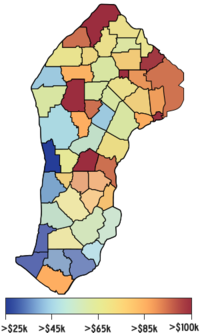
The economy of Verona is large enough to be comparable to that of the largest of countries. As of 2020, the gross state product (GSP) is about €6.145 trillion, the largest in Cartadania. Verona is responsible for 23 percent of the Cartadanian approximate €26.3 trillion gross domestic product (GDP).
The five largest sectors of employment in Verona are trade, transportation, and utilities; government; professional and business services; education and health services; and leisure and hospitality. In output, the five largest sectors are financial services, followed by trade, transportation, and utilities; education and health services; government; and manufacturing. As of January 2020, Verona has an unemployment rate of 3.1%.
Verona's economy is dependent on trade and international related commerce accounts for about one-quarter of the state's economy. In 2008, Verona exported €226 billion worth of goods, up from €194 billion in 2007 and €187 billion in 2006. Computers and electronic products are Verona's top export, accounting for 42 percent of all the state's exports in 2008.

